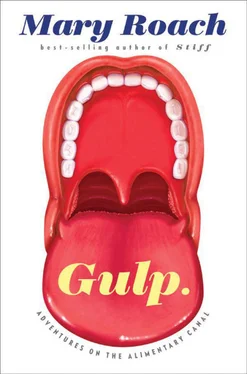It’s tough to find an inappropriate mealtime conversation with this group—not because they’re crass or ill-mannered, but because they view the universe of the colon very differently than the rest of us do. The interactions between the human body and its gut microbiome—as our hundred trillion intestinal roomers are collectively known—is a hot research area of late. For decades, medical investigators have looked at the role of food and nutrients in disease treatment and prevention. That has begun to seem simplistic. Now the goal is to tease apart the interactions between the body, the food, and the bacteria that break down the food. One example is the cancer-fighter du jour: the polyphenol family, found in coffee, tea, fruits, and vegetables. Some of the most beneficial polyphenols aren’t absorbed in the small intestine; we depend on colonic bacteria to metabolize them. Depending on who’s living in your gut, you may or may not benefit from what you eat. Or be harmed. Charred red meat has long been called a carcinogen, but in fact it is only the raw material for making carcinogens. Without the gut bacteria that break it down, the raw goods are harmless. (This applies to drugs too; depending on the makeup of your gut flora, the efficacy of a drug may vary.) The science is new and extremely complex, but the bottom line is simple. Changing people’s bacteria is turning out to be a more effective strategy for treatment and prevention of disease than changing their diet.
As a member of a culture that demonizes bacteria in general and the germs of other people in specific, you may find it disturbing to imagine checking into a hospital to be implanted with bacteria from another person’s colon. For the patient I’ll shortly be meeting, a man invaded by Clostridium difficile , it’s a welcome event. Infection with chronic C. diff —to use the medical nickname—can be an incapacitating and sometimes fatal illness.
“When you’re fifty-five years old and you’re wearing diapers that you’re changing ten times a day,” Matt Hamilton says, “you’re numb to the ick factor.” He lifts some stuffed tomatoes to his plate. Matt has the forceful, unabashed appetite of the big, young male.
“For the patient, there is no ick factor,” Khoruts adds. “They’ve been icked out. It’s a chronic disease and they just want to be rid of it.”
As regards bacteria in general, a radical shift in thinking is under way. For starters, there are way more of them than you. For every one cell of your body, there are nine (smaller) cells of bacteria. Khoruts takes issue with the them-versus-you mentality. “Bacteria represent a metabolically active organ in our bodies.” They are you. You are them. “It’s a philosophical question. Who owns who?”
People’s bacterial demographics are likely to influence their day-to-day behavior. “Certain populations in the gut may want you to eat a certain kind of diet or to store energy differently.” (A clinical trial is under way in the Netherlands to see if transplants of “donor feces” from lean volunteers will help subjects lose weight; [119] It’s called the FATLOSE trial. FATLOSE stands for “Fecal Administration To LOSE weight,” an example of PLEASE—Pretty Lame Excuse for an Acronym, Scientists and Experimenters.
thus far results are encouraging but undramatic.) Khoruts gave me a memorable example of how behavior can be covertly manipulated by microorganisms. The parasite Toxoplasma infects rats but needs to make its way into a cat’s gut to reproduce. The parasite’s strategy for achieving this goal is to alter the rat brain such that the rodent is now attracted to cat urine. Rat walks right up to cat, gets killed, eaten. If you saw the events unfold, Khoruts continued, you’d scratch your head and go, What is wrong with that rat? Then he smiled. “Do you think Republicans have different flora?”
What determines your internal cast of characters? For the most part, it’s luck of the draw. The bacteria species in your colon today are more or less the same ones you had when you were six months old. About 80 percent of a person’s gut microflora transmit from his or her mother during birth. “It’s a very stable system,” says Khoruts. “You can trace a person’s family tree by their flora.”
The party is winding down. I go into the kitchen to say good night to James and to Khoruts’s mirthful, tolerant girlfriend, Katerina. A blender sits on the counter by the sink, waiting to be washed. “Hey,” says James. “You missed the chocolate poop smoothies.”
That’s okay, because I’ll be seeing the real thing.
• • •
LIKE ANY TRANSPLANT, it begins with a donor. “Anyone’s will do,” says Khoruts. He has no idea which bacteria he’s after—which are the avenging angels that bring C. diff under control. Even if he knew, there’s no simple way to determine whether those species are present in a donor’s contribution. Most species of fecal bacteria are tough to culture in the lab because they’re anaerobic, meaning they can’t live in the presence of oxygen. (Common strains of E. coli and Staph bacteria are exceptions. They thrive inside people and out, on doctors and their equipment, and everywhere in between.)
The only thing Khoruts requires of donors is that they be free of digestive maladies and communicable diseases. Family members are not the most desirable donors because their medical questionnaire may not be entirely truthful. “You wouldn’t necessarily want to reveal to your loved ones that you’ve been visiting prostitutes.” Khoruts is partial to the donations of a local man who, understandably, wishes to remain anonymous. This man’s bacteria have been transplanted into ten patients, curing all of them. “His head is getting bigger,” deadpans Khoruts. Most of what Khoruts says is delivered deadpan. “In Russia,” he told me, “if you smile a lot, they think something’s wrong with you.” He has to remind himself to smile when he talks to people. Sometimes it arrives a beat or two late, like the words of a far-flung foreign correspondent reporting live on TV.
“Here he is.” A tall man, dressed for a Minneapolis winter, lopes down the hallway carrying a small paper bag.
“Not my best work,” the man says, nodding hello to me as he hands Khoruts the bag. With no further chitchat, he turns to leave. He does not seem embarrassed, just pressed for time. He’s an unlikely hero, quietly saving lives and restoring health with the product of his morning toilet.
Khoruts slips into an empty exam room and dials Matt Hamilton’s number. On the morning of a transplant, Matt will stop by the hospital on his way to the Environmental Microbiology Laboratory, where he works and the material is processed. He’s usually here by now, and Khoruts is feeling antsy. Anaerobic bacteria outside the colon have a limited life span. No one knows how many hours they can survive.
Khoruts leaves a message: “Hi, it’s Alex. The stuff is ready for pickup.” He squints. “I think that’s his number.” It would be a provocative message to receive from a stranger. I picture narcotics officers storming the gastroenterology department, Khoruts struggling to explain.
Khoruts has barely hung up when Matt hustles in, all polar fleece and apology. Matt smiles as naturally as Khoruts doesn’t. I imagine it is almost impossible to be peeved at Matt Hamilton.
The lab is ten minutes by car. Because Matt is driving fast and the cooler keeps threatening to slide off the backseat, there’s a mild tension in the car. The cooler is a tangible presence, somewhere between groceries and an actual passenger. Soon we’re circling, looking for parking. Matt resents the waste of time. “If I had organs, they’d give me a parking pass.”
Читать дальше












